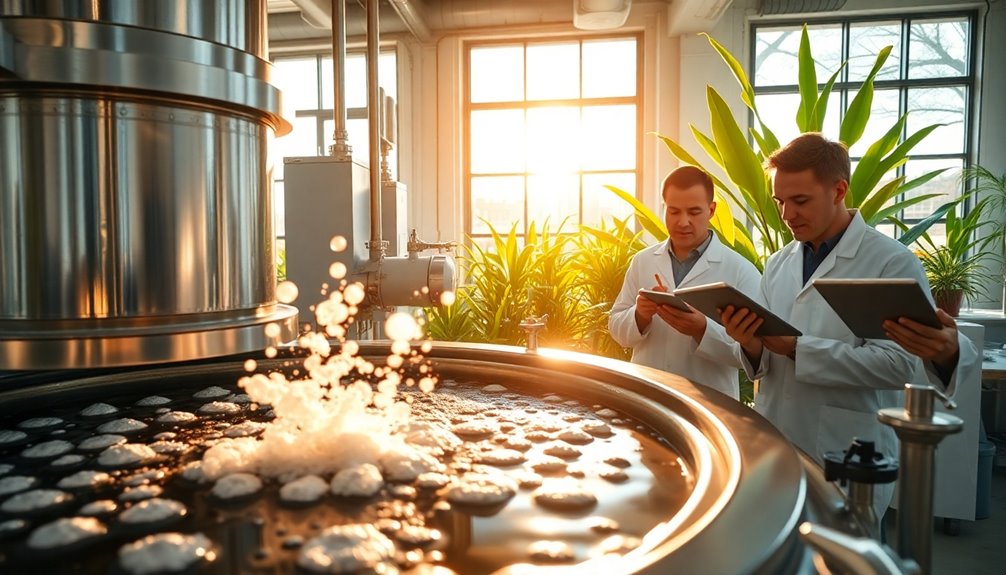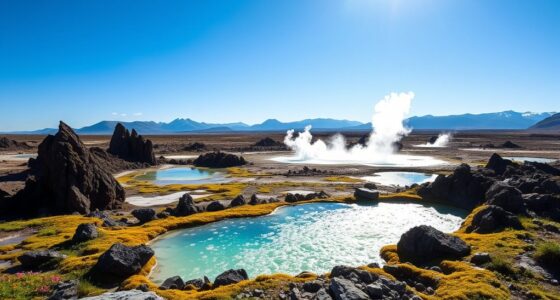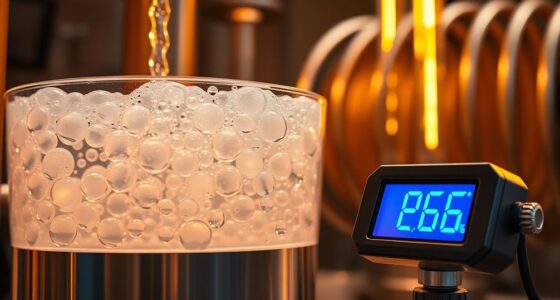Semi-thermophilic anaerobic digestion operates efficiently between 41–49°C, boosting methane yields while enhancing system reliability. You'll notice higher methane production and improved hydrolysis rates, which stabilize digestion and reduce volatile fatty acids. Its resilience to temperature fluctuations ensures consistent biogas quality and lower risks of dysbiosis. Plus, with shorter retention times and adaptable management, it meets diverse waste needs efficiently. There's more to discover about its environmental and economic benefits waiting for you.
Key Takeaways
- Semi-thermophilic anaerobic digestion enhances methane yields by optimizing temperatures for favorable methanogenic microorganism conditions.
- The process reduces volatile fatty acid accumulation, stabilizing digestion and improving overall performance.
- Increased microbial community resilience minimizes risks of dysbiosis, ensuring consistent biogas quality.
- Lower sensitivity to temperature fluctuations contributes to system reliability and easier operational management.
- The approach offers environmental benefits and reduces waste management costs while producing high-quality digestate for agricultural use.

As you explore sustainable waste management solutions, you might find that semi-thermophilic anaerobic digestion offers a compelling balance between efficiency and stability. Operating between 41–49°C, this process accelerates biochemical reactions, enhancing methane yields while maintaining a reliable system. It combines the stability of mesophilic digestion with the efficiency of thermophilic systems, making it an attractive option for optimizing waste management.
One of the main benefits of semi-thermophilic conditions is the potential for higher methane production compared to traditional mesophilic systems. The optimized temperatures promote favorable conditions for methanogenic microorganisms, leading to enhanced methanogenesis. Moreover, the process reduces the accumulation of volatile fatty acids, which stabilizes digestion and prevents process failures. With improved hydrolysis rates, organic matter conversion becomes more efficient, making this option a smart choice.
Semi-thermophilic conditions enhance methane production, stabilize digestion, and improve organic matter conversion efficiency.
In terms of system reliability, semi-thermophilic digestion proves advantageous due to its reduced sensitivity to temperature fluctuations. This means you can expect better resilience and diversity within the microbial community, lowering the risks of dysbiosis and ensuring more consistent biogas quality. Such stability can help you recover more easily from operational disturbances, making the process more dependable.
Operationally, semi-thermophilic systems demand lower heating costs compared to their thermophilic counterparts. You'll find that these systems often require shorter retention times without sacrificing efficiency, making management easier. Their adaptability to different waste types and compositions further enhances their appeal, allowing you to optimize waste processing based on specific needs.
In addition to environmental benefits like contributing to global warming mitigation, semi-thermophilic anaerobic digestion can also yield economic advantages by reducing waste management costs. The high-quality digestate produced is suitable for agricultural use, promoting energy independence in resource-limited areas.
As research continues, exploring optimal temperature ranges and comparing this method to traditional systems will further unlock its potential.
Frequently Asked Questions
What Types of Feedstock Are Suitable for Semi-Thermophilic Anaerobic Digestion?
For semi-thermophilic anaerobic digestion, you'll want to use suitable feedstocks like organic household waste, agricultural residues, and animal manures.
Greens and weeds can also be effective, especially when mixed with other materials.
Pay attention to the moisture content and aim for a carbon:nitrogen ratio of 20-30:1 for optimal microbial growth.
Properly preparing and mixing these feedstocks will enhance the digestion process and improve overall efficiency.
How Does Semi-Thermophilic Digestion Compare to Mesophilic Digestion?
When you compare semi-thermophilic digestion to mesophilic digestion, you'll notice key differences.
Semi-thermophilic systems operate at higher temperatures, which can enhance organic matter breakdown and yield more biogas.
However, mesophilic digestion often provides more stability and a diverse microbial community.
You'll find that while semi-thermophilic conditions can increase methane production rates, they also require careful management to maintain system reliability.
Ultimately, each method has its advantages depending on your specific goals.
What Are the Potential Downsides of Semi-Thermophilic Anaerobic Digestion?
When considering semi-thermophilic anaerobic digestion, you might face several downsides.
Temperature fluctuations can compromise system stability, leading to reduced methane production. Maintaining consistent temperatures requires precise control, adding complexity to operations.
You may also deal with higher levels of pathogens in the digestate compared to thermophilic systems, impacting quality.
Additionally, operational challenges like foaming and the need for frequent monitoring can increase your workload and costs.
How Can System Ph Levels Affect Methane Production?
Imagine a delicate balance, like a tightrope walker, where pH levels sway between extremes.
If you let the pH dip too low or rise too high, you risk stalling methane production.
Methanogenic bacteria thrive around pH 7.0, so maintaining this sweet spot ensures they work efficiently.
What Monitoring Techniques Are Used in Semi-Thermophilic Anaerobic Digestion Systems?
In semi-thermophilic anaerobic digestion, you'll want to use several monitoring techniques to ensure efficiency.
Gas chromatography helps you analyze methane content, while pH meters keep track of pH levels.
Wet gas meters measure daily biogas production volumes, and titration methods assess total alkalinity and volatile fatty acids.
Conclusion
In embracing semi-thermophilic anaerobic digestion, you're not just optimizing methane yields; you're also investing in a sustainable future. It's like nurturing a seed—what you cultivate now will flourish into robust energy solutions later. By operating in the 41–49°C range, you're enhancing system reliability while reducing waste. So, why not take this vital step? The benefits are clear: a greener planet and a more efficient energy source await you, ready to be harnessed for years to come.









